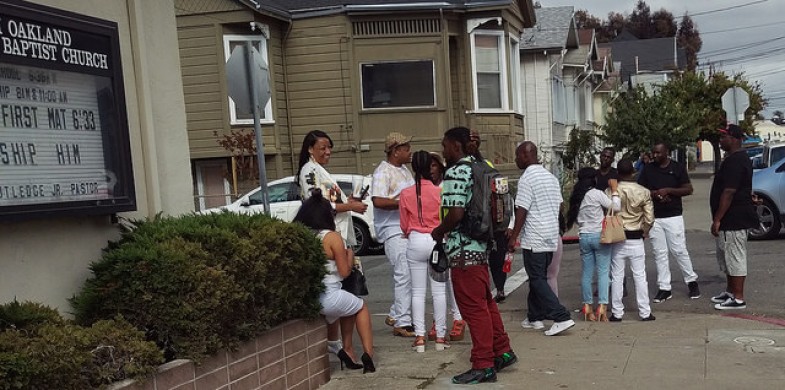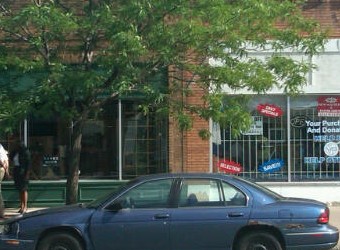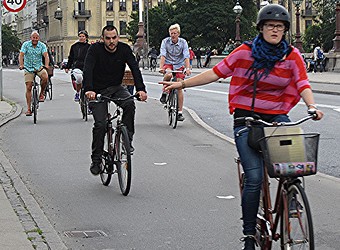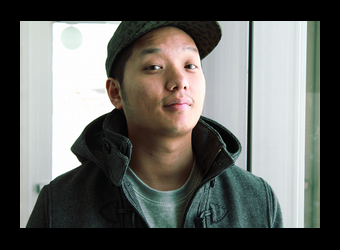People have walked for justice and economic opportunity throughout American history.
Slaves seeking freedom hiked hundreds of miles on the Underground Railroad, guided by heroes like Harriet Tubman. Workers wanting a better life for their families walked on picket lines and at protests, rallied by advocates like Cesar Chavez. People demanding civil rights marched in Selma, Alabama and the National Mall in Washington, led by Rev. Martin Luther King Jr.
Walking is a powerful tool to change the world as well as a fundamental human right. To be restrained from free movement is an injustice, a denial of our liberties, a betrayal of American ideals. And it closes off the commons, which all of us should be able to enjoy equally.
Yet many people across the country now think twice before traveling on foot due to dangerous traffic, street crime, racial profiling, or a lack of stores and public places within walking distance. Forty percent of all Americans say their neighborhood is not very walkable, according to a survey commissioned by Kaiser Permanente, one of America’s largest healthcare providers. A full quarter of Americans report they are deterred from walking by speeding traffic or lack of sidewalks, and 13 percent say crime keeps them indoors.
These numbers rise even higher in disadvantaged communities, compounding already serious problems of poor health, limited transportation options, and overall disillusionment.
A wealth of recent medical research, highlighted in the Surgeon General’s recent Call to Action on Walking, promotes walking as a way to prevent chronic disease, heart disease, diabetes, depression and some cancers. The US Centers for Disease Control and Prevention recommends everyone walk or engage in other moderate exercise half an hour a day five days a week. (An hour a day for children.)
Poor conditions for walking among low-income households, people of color and some immigrant communities limit their access to jobs and education. One-third of all African-Americans and one-quarter of all Latinos live without access to a car, according to a report by the Leadership Conference Education Fund, which means walking and public transit (which involves a walk) represent important pathways to opportunity.
Improving walking options can also help ease the financial burdens on poor families, which spend 42 percent of their income on transportation compared to 22 percent among middle-income Americans. That’s because the average cost of owning and operating one car is $8700 a year .
“This is an issue of equity,” says Gil Peñalosa, founder of 8 80 Cities and an immigrant from Colombia. “A big thing we could do to help low-income families is to make it easier to live without a car. And it would help middle-class families to switch from two cars to one.”
“I was in Brownsville, Texas, which is majority Hispanic and one of the poorest communities in America, where the average income is half the national average,” remarks Peñalosa. “Yet over 90 percent of trips there are still by car. That’s why the city’s new plans for biking, walking and trails can make a difference.”
Making America more walkable for people of all incomes and races is a major focus of the National Walking Summit, held in Washington, DC Oct. 28-30. Our mission is “to make sure walking is accessible for everyone, especially vulnerable populations in lower socioeconomic communities where infrastructure has not been invested in and pedestrian and public safety are significant issues,” says Tyler Norris, one of the events’ organizers and vice-president of Kaiser Permanente, which is among 20 co-sponsors including AARP, the National Association of Realtors, the Every Body Walk Collaborative, The Robert Wood Johnson Foundation, the Kellogg Foundation, the Knight Foundtion and America Walks. The summit is organized by America Walks.
Barriers to Walking
So what stops people of color and those living low-income communities from walking more?
There are “disproportionately high pedestrian deaths in low-income communities,” according to US Department of Transportation specialist Paul Heberling. He notes that pedestrians in the poorest one-third of urban census tracts are twice as likely to be killed as those in other neighborhoods. African-Americans are 60 percent more likely to be killed by cars while walking, and Latinos 43 percent.
That’s because people walking in “low-income communities are less likely to encounter sidewalks, street/sidewalk lighting, marked crosswalks and traffic calming measures,” concluded a health report from the Robert Wood Johnson Foundation.
This disparity helped spur US Secretary of Transportation Anthony Foxx to launch his Safer People, Safer Streets initiative to help everyone walk and bike more. “This is the safest time for transportation in history, except for pedestrians and bicyclists,” he said.
In addition to traffic injuries, other barriers to walking for low-income people and racial minorities include: inadequate infrastructure, fear of crime, no appealing destinations to walk to and a stigma that people on foot are “losers, ” explains Yolanda Savage-Narva, Director of Health Equity at the Association of State & Territorial Health Officials.
Growing up in African-American communities in both the North and South, Savage-Narva recalls, “We walked very seldom on the South Side of Chicago because of crime. And in Mississippi, it wasn’t normal to walk. It was something that only really poor people did. I never walked except when I drove to the park to take a walk.”
How you travel looms large as an emotional issue in disadvantaged communities, according to Peñalosa. “Walking is seen as a symbol of failure. And you can see why when you look at the places where many people are forced to walk-- deteriorating infrastructure, dangerous intersections. It’s like we are telling these people every day that they are second class citizens.” Indeed, sidewalks in heavily African-American neighborhoods are 38 times more likely to be in poor shape, according to Active Living Research.
Savage-Narva stresses that cultural attitudes also affect how people view walking in low-income communities in other ways. “The word ‘exercise’ carries a different meaning. Some people will think you’re crazy if you suggest taking a walk after they’ve worked a 12-hour shift.”
“It’s important to get at the root of what will inspire all people to walk,” Savage-Narva says about promoting walking in poor neighborhoods. “Emphasize the freedom of taking a walk to where you want to go. It’s a civil right that people have died for---and, of course, it also has many health benefits too.”
“Walking for fun has not been a big part of the experience of people of color and low-income people,” concurs Anita Hairston, Associate Director and transportation specialist at Policy Link, a national institute focused on social equity. “They walk because they need to get to work or somewhere else.”
She offers another reason straight out of today’s headlines to explain why many African-Americans, Latinos and immigrants are wary about taking a stroll. “The issue of racial profiling is front and center. Who’s got the right to be on the streets? If a group of young black men are dressed casually, people think: Where is this gang going? What are they going to do?”
The deaths of Trayvon Martin in Sanford, Florida and Michael Brown in Ferguson, Missouri, among many others, shows “not everyone has the same experience on the street,” Hairston adds.
Despite all these roadblocks, people in disadvantaged communities still walk more than other Americans. “The fact is that we have twice as many low-income children who are walking or biking to school than those in affluent neighborhoods, even lacking the infrastructure to protect the children who walk and bicycle,” reports Keith Benjamin, a Campaign Manager for the Safe Routes to Schools National Partnership.
RX for a Hidden Health Care Crisis
A little publicized crisis for African-Americans is the high rate of heart disease and diabetes, especially among women, says Vanessa Garrison, co-founder of the health empowerment program Girl Trek. “Everyday we are losing women we love. Women our families depend on.”
“The leading cause of death for black women is heart disease,” Garrison notes. “We are dying younger and at higher rates from preventable diseases than any group of women in this country. Eighty percent of black women are overweight. Half of all black girls born in 2000 will get diabetes by 2034 if present trends continue.”
Girl Trek aims to improve black women’s health by organizing communities to walk, even in places where sidewalks are absent and crime rates are high.
“We walk to heal our bodies, inspire our families and to reclaim the streets of our neighborhoods,” proclaims the organization’s mission statement… “Each day we walk away from traumas of chronic stress, generational poverty, addiction, unemployment, failing schools, mass incarceration. Each day we walk in the direction of our healthiest, most fulfilled lives.”
More than 35,000 African-American women have taken Girl Trek’s pledge to re-establish walking as a healing tradition in their neighborhoods. Detroit, St. Louis, Atlanta, Washington, DC and Jackson, Mississippi sport the most active chapters. More than 500 Girl Trek members traveled to Alabama last spring to walk in celebration of the Selma-to-Birmingham March, which in 1965 solidified the power of the Civil Rights movement by defying white supremacists’ restrictions on where African-Americans could walk.
On Foot in Anacostia
Fifteen to 20 women in Anacostia, one of the poorest neighborhoods in Washington, D.C., take an invigorating 3.3 mile walk every Saturday morning as part the Just Walk club sponsored by the neighborhood’s Community Wellness Collective. Khadijah Tribble, a public health consultant, shows me the route starting at the Anacostia Arts Center , which follows battered sidewalks and crosses streets with roaring traffic until reaching a walking path along the Anacostia River.
“People here have this idea that exercise is just for people with money, people with time,” she says. “That’s why we walk. To show that’s not true. But time is one of the biggest barriers, especially for a lot of people who spend many hours each week getting to and from work on the bus.”
Another common misconception, she notes, is that walking is not really exercise. “They say if you’re not sweating profusely, you’re wasting your time.” Tribble refutes that by pointing to her own experience. She walks 3-5 miles a day around the neighborhood as part of weight loss program on which she has lost significant weight.
“When I walk, it shows me that I am taking care of myself,” she explains. “It reminds me not to indulge in foods that are not good for me. It’s my touchstone. I feel so powerful in just choosing to walk.”
The appeal of walking is fun as much as health for women in Anacostia, Tribble says. “People in the group meet, they socialize, they connect. Some have become friends outside the group.”
Take to the Streets in Chicago
A walking club can be spotted every Thursday evening on the sidewalks of West Humboldt Park, a largely African-American and Latino neighborhood on the West Side of Chicago. They’re part of a program to increase walking and improve health sponsored by the West Humboldt Park Development Council (WHPDC).
“This area has one of the higher diabetes rates in the nation,” explains Isaiah Ross, until recently WHPDC’s community development manager. “People haven’t walked much here because the traffic makes it hard to get to school or work, and people are afraid to go out because they don’t know their neighbors.”
The challenges of walking here are clearly visible on a short stroll through the neighborhood, but so are the rewards. Vehicles move fast and furious on the four lanes of Chicago Avenue, with only minimal accommodations for pedestrians wanting to cross the street. Yet tree-shaded residential streets lead to the green lawns of Humboldt Park and Garfield Park, gems of 19th Century landscape architecture with lagoons, ballfields, picnic grounds, a conservatory and music stages.
The Healthy Community Initiative aims to break down people’s isolation, first by bringing neighbors together and then tackling issues that discourage healthy lifestyles. Groups of 8-10 are being organized to tour their immediate neighborhood conducting walk audits and public safety audits. “Are the crosswalks visible at intersections? Is the lighting good enough? Are there places for people to go in an emergency? What can be done to slow down traffic? What’s a safe route for kids to go to school? Are there any signs of gang activity? Where are the places in the neighborhood where people want to go?” are among the questions they seek to answer, according to Ross.
Five new playgrounds have been built recently in the neighborhood and the city of Chicago has begun sponsoring Play Streets events, where a block is closed off to traffic and people of all ages come out to play basketball, twirl hula hoops, compete in tugs of war, jump in a Bounce House and get to know one another. The Healthy Community Initiative hosts a farmers’ market every Saturday---complete with music performances and cooking classes--- and offers fitness classes for 10 different physical activities, including walking.
“When I first got here, I never saw anyone out walking just for fun,” Ross says. “Now I do.”
Stepping Up in Suburbs
Not all low-income families and people of color live in cities, of course. Suburban residents now outnumber those living in cities among African-Americans, Latinos and Asian-Americans.
More poor people live in suburbs today than in cities, too, and often experience even greater problems because of spotty public transit, lack of sidewalks, wide streets with few pedestrian safety measures and greater walking distances to destinations.
Almost 20 percent of the population of Richmond, a suburban city of 100,000 in the East Bay region of California, live below the poverty line. The city’s struggling Iron Triangle neighborhood---which is approximately 2/3 African-American and 1/3 Latino---has long suffered from poverty and high crime rates, says Dan Burden, a walkability expert at Blue Zones, who has worked in 3000 US communities. Local people seeking to improve their community joined hands to restore Pogo Park, and are now working to make neighborhood routes to the park safe for pedestrians by improving the street design to encourage slow traffic and create a more appealing environment for walking. “This is creating a place filled with lots of things for people to do, where gangs will not go to sell drugs or bully everyone,” Burden says.
Nowhere in America is driving is more entrenched as a way of life than the suburbs of Los Angeles. But Baldwin Park, a heavily Latino community notable for its numerous drive-through restaurants, took a stand to make it easier and more enjoyable to walk. The city-sponsored group People on the Move (POTM) brought together officials from health care, government, citizens groups and the schools to launch a six-week boot camp to train community leaders in advocating for better nutrition and active transportation. Kids were a major focus of the project, and were deeply involved in successful campaigns to raise consciousness about walking issues, establish a Safe Routes to School program, pass a Complete Streets ordinance and hire a full-time city employee working on health and urban design. After five years of effort, fitness tests of local school kids registered a 13 percent decrease in Body Mass Index.
Walk in the Country
In rural America---which is poorer on average than urban regions and where one in five residents is Latino, African-American or Native American---walking is more common than most people think. Even with long distances to destinations and very limited public transit options, 1.6 million rural households do not have access to cars.
Small town residents walk almost as much as Americans living in metropolitan areas, according to a report from Rails to Trails Conservancy. In towns sized 2500-10,000, 7.2 percent of all trips are made on foot and 8.5 percent in towns 10,000 - 50,000, compared to national average of 10.5 percent (and 6.7 percent in newer suburbs), according to the US Department of Transportation.
And rural Americans are enthusiastic about walking. Nine out of ten want to see their communities become more walk-friendly according to a recent survey from the Safe Routes to Schools National Partnership, and 81 percent want to increase or maintain current public spending on sidewalks and bikeways.
The problems that walkers in rural communities encounter are sometimes different than those in cities and suburbs. “Aside from isolated geography, we’ve found that stray dogs are a big issue in some places,” notes Mikaela Randolph, Campaign Manager for State Routes to Schools National Partnership.
In Winton, a largely Latino town of 10,000 in California’s Central Valley, parents were wary about kids walking or biking to school due to traffic congestion and lack of sidewalks. The school district responded by declaring walk-to-school day, plus hosting events and teaching classes about safety on the streets. Then they drafted their own Safe Routes to Schools policies, with help from the Safe Routes to Schools National Partnership and ChangeLab Solutions.







